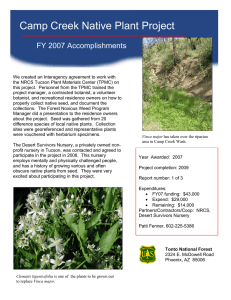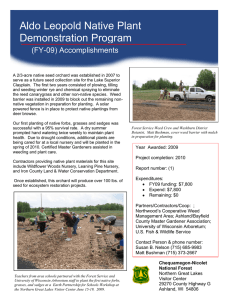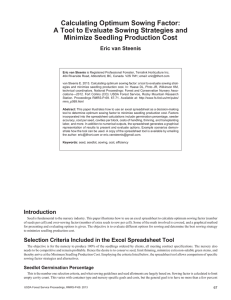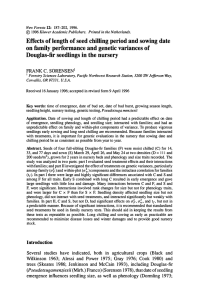Document 11872747
advertisement
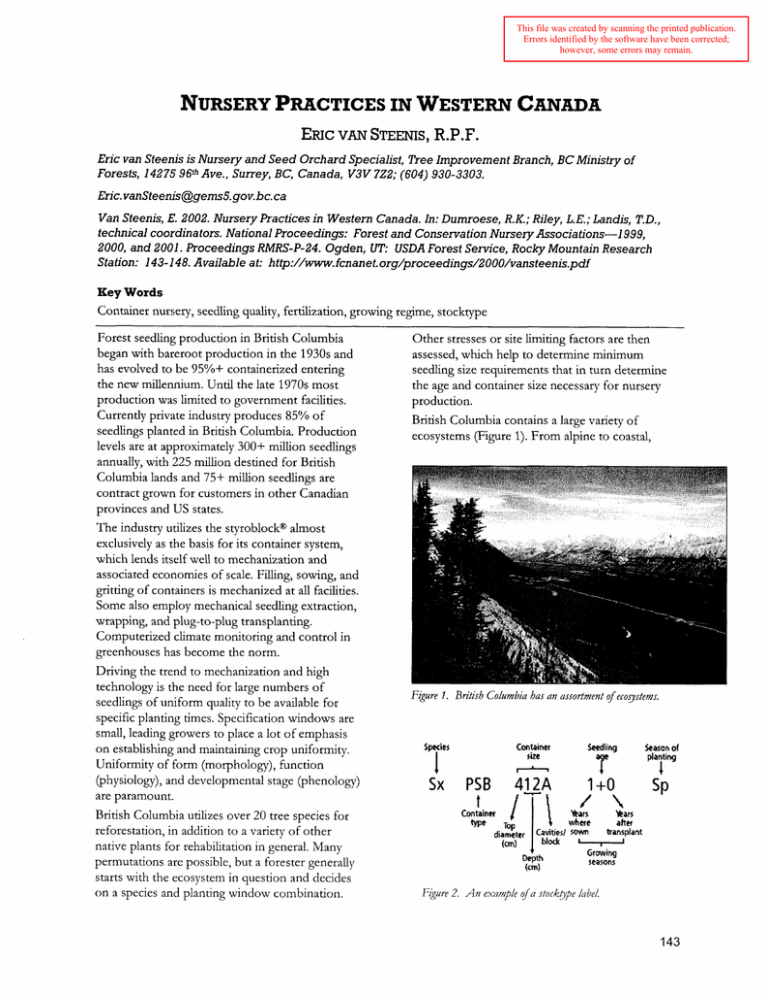
This file was created by scanning the printed publication. Errors identified by the software have been corrected; however, some errors may remain. ERICVAN STEENIS, R.P.F. Eric van Steenis is Nursery and Seed Orchard Specialist, Tree Improvement Branch, BC Ministry of Forests, 14275 96th Ave., Surrey, BC, Canada, V3V 722; (604) 930-3303. Eric. vanSteenis@gemsS.gov.bc.ca Van Steenis, E. 2002. Nursery Practices in Western Canada. In: Dumroese, R. K.; Riley, L.E.; Landis, T.D., technical coordinators. National Proceedings: Forest and Conservation Nursery Associations-1 999, 2000, and 2001. Proceedings RMRS-P-24. Ogden, UT: USDAForest Service, Rocky Mountain Research Station: 143-148. Available at: http://www.fcnanet.org/proceedings/2000/vansteenis.pdf Key Words Container nursery, seedling quality, fertilization, growing regime, stocktype Forest seedling production in British Columbia began with bareroot production in the 1930s and has evolved to be 95'/0+ containerized entering the new millennium. Unul the late 1970s most production was limited to government facilities. Currently private industry produces 85% of seedhngs planted in British Columbia. Production levels are at approximately 300+ million seedlings annually, with 225 mdlion destined for British Columbia lands and 75+ million seedlings are contract grown for customers in other Canadian provinces and US states. Other stresses or site limiting factors are then assessed, which help to determine minimum seedling size requirements that in turn determine the age and container size necessary for nursery production. British Columbia contains a large variety of ecosystems (Figure 1). From alpine to coastal, The industry utilizes the styroblock@almost exclusively as the basis for its container system, which lends itself well to mechanization and associated economies of scale. Filling, sowing, and gritting of containers is mechanized at all facdities. Some also employ mechanical seedling extraction, wrapping, and plug-to-plug transplanting. Computerized climate monitoring and control in greenhouses has become the norm. Driving the trend to mechanization and high technology is the need for large numbers of seedlings of uniform quality to be available for specific planting times. Specification windows are small, leading growers to place a lot of emphasis on establishing and maintaining crop uniformity. Uniformity of form (morphology), function (physiology), and developmental stage (phenology) are paramount. British Columbia utilizes over 20 tree species for reforestation, in addition to a variety of other native plants for rehabilitation in general. Many permutations are possible, but a forester generally starts with the ecosystem in question and decides on a species and planting window combination. Figtlre 1. Bn'tish Colmbia has an assortment of ecoytems. Growing seasons I;igt/re 2. A n example of a stockgpe Label. prairie to desert, and everything in between, challenges abound. T o overcome the large variety in site limiting factors when reforesting requires a variety of stocktypes. A stocktype (Figure 2) is a species/container type (or bareroot)/age class/planting season combination. Knowing a nursery's production capability, one works back from the final delivery date through shipping, packaging, lifting, grading, and growing to determine an appropriate sowing date. Planning also includes seed procurement, preparation, and possible upgrading. To ensure initial survival and growth, seedlings are planted during phases of active root growth. Root growth potential is highest in spring prior to budflush and in late summer and fall after budset (Figure 4). If planting windows do not coincide with natural phases of root growth, then cultural techniques in the nursery are used to shift seedling phenology. The most common treatment used to induce shoot terminal budset is blackout (shortday treatment). Inducing budset also causes a shift of seedling resources from growth to differentiation, resulting in an increase in overall hardiness and stress resistance. Planning Using known information about the nursery and desired seedling product, a determination is made as to what to plant. Figure 3 shows a growth curve used for this planning. This curve is drawn from right to left, starting with final seedling size (specifications) and planting window (delivery date) requirements. If the stocktype is new, then a hypothetical growth curve is generated using nursery experience and consultation with others. GROWTH CURVE -6 -4 -2 0-2 ' 4 6 8 '10 12 14 16 18 20 22 24 26 28 30 -HEIGHT Weeks -RCD F@re 3. Growth ctlrve tlsed toplan nursey prodtrction. North of the 49th parallel, a greenhouse (Figure 5) is imperative because of climate. T o allow production of a variety of stocktypes often requires "growing" outside the natural growing season. Basically, this means extending greenhouse culture at either or both ends of the crop cycle. one's control, but the latter three are constantly being upgraded. Computerized greenhouse climate monitoring and control has become the norm, as well as the use of photoperiod control, rolhng benches, shade and blackout screens, and SO on. The number of hours of sunshine, grower expertise, facility/equipment capabilities, and plant genetics together determine potential biological productivity. Sunshine hours are outside The industry utilizes the styroblock almost exclusively as the basis for its container system, which lends itself well to mechanization and associated economies of scale. Filling, sowing, and gritting of containers is mechanized at all facilities. Canadian sphagnum peat is the base growing media ingredient; other amendments vary among nurseries. Sowing Seed sowing is automated (Figure 7) to minimize seed damage, place seed accurately in the center of each cavity, and reduce the time from first to the last seed sown. This results in more uniform emergence. Each individual step involved during container loading and seed sowing is designed to ensure the creation of a uniform microenvironment for the germinating seed. Prior to sowing, cavities are dibbled to exactly the same depth. Immediately after sowing, a uniform layer of grit (3- to 5-mm depth depending on seed size/container sizelseed vigor) is applied as a seed cover, followed by an initial watering to maintain seed imbibition until placement under the greenhouse irrigation system. What drives the trend to mechanization and high technology is the need for large numbers of seedlings of uniform quality to be available for very specific planting times. ANNUAL CYCLE OF SEEDUNG GROWTH Mar Apr May Jun Jul Aug press, and animal browse anticipated at the reforestation site. Figure 8, the scatter diagram, shows a crop with a minimum specification of 15 cm height by 3.2 mm root collar diameter. A maximum height of 35 cm is specified, which, if surpassed, requires a root collar diameter equal or greater than the target of 5.5 mm. Target height is halfway between minimum and the maximum at 25 cm. F@re 5. Greenhome used toproduce stock. ofnew4 germinated seed in a container. Sep Oct Nov (adaptedfrom Landis b Fisher, 1986) F&we 4. The gdes $seedling growth are wed to assist in enstlring seedling mrvivaI and growth. Morphology (outward appearance) is one measure of quality, and it also functions well for contract adjudication purposes. However, morphological specification windows are small, forcing growers to place a lot of emphasis on establishing and maintaining crop uniformity. Size can overcome physical stresses such as snowpress, vegetation F@re 7.Automatedjlling enmres ejkient loading. U n $ m mixing of ingndients, consistent den.@, and minimal degradation oftbe peat base are goals. An added challenge is that quality is defined in several additional ways. Survival and performance require more than just correct morphology. Emphasis is also placed on uniformity of form (morphology), function @hysiology),and developmental stage (phenology), with appropriate 1.5 2 2.5 3 3.5 4 4.5 5 5.5 6 6.5 7 7.5 8 8.5 RCD in mm F@re 8. Relationship between root collar diameter to height. anatomy and growth-differentiation balance expected. Physiology applies to processes such as photosynthesis, which supplies the energy required to maintain survival, drive plant growth, repair damage, and so on. The machine that converts light energy to chemical energy has to be in top shape! Phenology is the study of the relationship between climate and periodic biological phenomena such as bird migration or plant flowering. Our industry is concerned with the timing of bud flush/bud induction/root growth phases. Temperate zone plants and their constituent parts go through growth cycles. During the planting phase, root growth cycles need to be on the upswing. The latter assures better access to soil moisture and consequently correlates highly with initial survival, particularly on dry sites. Also, to ensure energy can be allocated to root growth, cessation of shoot growth (a set terminal bud) is preferred. Anatomy, or internal structure, comes into play when assessing such things as bud viability. Growth-differentiation balance gives an indication of degree of stress resistance that can be expected from a seedling. A woody stem and fully differentiated needles containing a reasonable complement of protective waxes and cuticle thickness is desired to impart increased resistance to mechanical stress, high light intensity and drought. The phrase "Fitness for Purpose" comes to mind. Uniformity Since uniformity is a focal point, how do we maximize it? Uniformity is like running a race, it is won (or lost) at the start. The key is establishing it at the beginning and maintaining it from that point on. Step 1 is obtaining quality seed and preparing it such that all of it is ready to germinate at the same time with the same vigor. Germination environment is next. Since germination is fueled in part by respiration of stored reserves in seed, and respiration rate increases with temperature, germination speed can be controlled. Increasing temperature increases respiration rate and subsequent germination speed which leads to uniform emergence. This strategy is particularly useful when single sowing. Multiple sowing employs thinning as a means of reestablishing crop uniformity early on. When managing the germination environment, it is imperative to manage seed/plant conditions and the boundary layer around the developing seedling. During the crop cycle, one maintains uniform growth through the application of uniform growing conditions (temperature, humidity, light, COz concentration) around each seedling. Greenhouse climate monitoring and management is paramount. Various tools are used to increase climate uniformity such as horizontal airflow fans and screens. Climate control computers increase strategic options for managing climate. They can anticipate needs based on monitored data and trend analysis and allow for integrated control of various parameters and equipment. Monitoring during grower absences increases diagnostic capability. Using a built-in weather station, one can utilize light dependent venting/misting/ temperature control, thereby exercising more control over net photosynthesis. acting early based on the observed trend. In Figure 10, Fe (iron) addition causes Mn (manganese) reduction in the foliar tissue sample. Constant liquid fertigation of all pertinent elements is practiced. Target tissue levels are based on experience, and monitoring serves to maintain optimum levels. For example, foliar nitrogen levels during active growth are maintained between 2% and 3% (of dry wt.). T o prepare for overwinter storage, growers target closer to 2% to reduce the susceptibility of foliage to storage molds and Botytis. Monitoring If you are not monitoring you are not managing! Figure 9 shows the continuous decline of K (potassium) over the growing season. An impending deficiency can be easily avoided by Tissue Andysis PI PCT 410 Macros 94 115 136 157 178 199 220 241 262 Julian Day Figure 9. Monitoring trendr can allowpreventative measures. Tissue Analysis PI KT410 Micros . A - 1 Julian Day F@re 10. Adding iron can cause a reduction ofmnnganese. 283 Imparting appropriate phenology for overwintering involves accurate control over budset induction timing. Once achieved, post-bud set induction growing regimes are set up to maintain budset and encourage further differentiation of tissue. Photoperiod Control Photoperiod extension is used to maintain vegetative growth (prevent premature terminal budset induction and associated height growth cessation) during the growing season or for highlatitude provenances growing in lower latitude nurseries. Photoperiods of 18 to 24 hours are common. Longer photoperiods are employed on high-elevation and northern latitude provenances. Night-break lighting works as well. A shortened photoperiod is used to obtain uniform budset induction timing in the whole crop. Ten- to fourteen-hour days are utilized for anywhere from 5 days to 3 weeks, depending on species, provenance, planting window, and nursery location/culture. Longer days work on far-north provenances, whereas shorter days are preferred on southern material. Treatment duration increases with lower latitude and more vigorous provenances. Dormancy For final hardening, growers prefer exposure to outside conditions coupled with lowered overall nutrition, utilizing a "finisher" regme. Finally, mechanized extraction, grading, counting, and labeling may be employed during harvesting. Then, for regular 1+0 seedlings, frozen storage coupled with a quick thaw (to maintain uniformity) finishes the nursery phase. Stocktype selection focuses on field performance, or "fitness for purpose," with an emphasis on a certain morphology, physiology, and phenology. Uniformity is imperative. REFERENCES McClarnon, J., Eastham, A. 1998. Provincial seedling stock type selection and ordering guidelines. British Columbia Ministry of Forests, Victoria, BC. page 71. Landis, T.D.; Tinus, R.W.; McDonald, S.E.; Barnett, J.P. 1994. The container tree nursery manual. Agriculture Handbook 674. Washington, DC: U.S. Department of Agriculture, Forest Service.



